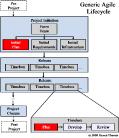Kim Daubney asked “What to do when stand ups leave you none the wiser”? What you do really depends on why you are “none the wiser”. Do you have a knowledge gap or is the wrong information being shared?
Continue reading
Tag Archives: heartbeat
Three Amigos Meeting – Agree the tests before development starts
“Three Amigos” is what Matt Wynne calls the meeting to discuss the Gherkin scenarios before development starts. The Three Amigos involves the business, development and testing voices. However who turns up, where they meet, what they produce in the meeting, the homework to complete after the meeting, and who does that homework can all vary depending on the particular team.
Continue reading
When Meeting Madness Strikes
Some people and some organisations like meetings. If you drop Agile with its Agile Heartbeat into the mix then you might find that meeting madness strikes.
I’m a Kiwi living in the UK and I’ve noticed the British will form a queue if given the barest of excuses. Similarly, in some organisations, the people will call a meeting at the drop of a hat. People in coordination roles (e.g. project manager, discipline lead) seem particularly prone to this.
Don’t.
Continue reading
Case Study: Motivating a team using Agile practices
A while ago I did some consultancy with an Israeli company that was kicking off a large, complicated and challenging project. They wanted advice on how to motivate the team so I looked in my toolkit – both Agile and general management – and suggested a few things.
It is worth emphasising that the company’s sole concern in this case, and the reason for my engagement, was "motivation" and not Agile per se.
Continue reading
Agile Project Planning
No battle plan survives contact with the enemy
Plans are nothing, but planning is everything
Field Marshal Helmuth Graf von Moltke
 I believe that Agile Project Management provides certainty of delivery. Planning is what lets us answer the question “When will you be finished?”. Planning is, however, just the start of the process. As Moltke pointed out planning is more important that the plan because once you start the project you’ll find the plan is wrong and you have to adapt. All plans need revisiting and you will have to use Agile Project Control, Agile Change Management, and Agile Risk Management to get the promised certainty of delivery.
I believe that Agile Project Management provides certainty of delivery. Planning is what lets us answer the question “When will you be finished?”. Planning is, however, just the start of the process. As Moltke pointed out planning is more important that the plan because once you start the project you’ll find the plan is wrong and you have to adapt. All plans need revisiting and you will have to use Agile Project Control, Agile Change Management, and Agile Risk Management to get the promised certainty of delivery.
Continue reading
Agile Lifecycle / Agile Heartbeat
All software development methods, including the Agile ones, have some sort of underlying project lifecycle. System Development Lifecycle (SDLC) is the common name for a software development process, but in the Agile world I prefer calling it a “heartbeat” reflecting the organic nature of an Agile project. Some of the big Agile methods don’t make a big deal of the heartbeat and others do. Some have such abstract lifecycles that it is actually hard to know what activities to schedule. And they all use different terms for the same thing. I have pulled out the common activities to create a generic agile lifecycle.
Continue reading
One Page Agile Standard for team of 350
For the last two years I have been rolling out a standard Agile approach to a department of 350. One part of the roll out strategy was to have a published standard. This was to make the goal / end-game obvious even if we didn’t initially mandate everything.
The first version of the standard, published Oct 2006, was a 50 page document. Earlier drafts had been quite short but in reviewing the document people kept asking “What does that mean?” so we’d add another section explaining it. All rather worthy but, aside from the initial reviews before publication, nobody read it. And it diluted the document as a standard, defining what must be done, as opposed to a guideline about how to do it.
We published version 2 today. This version of the standard is one page. I want to give people a simple checklist so they know whether or not they are following the standard.
Continue reading
An Agile Comparison
This is an article I wrote some years ago when I was trying to get my head around “What is Agile?” and “What is the difference between the different methods?”. It is a bit dated now but I’ve kept it on the website as the third question “Is Agile good Project Management?” is still what I’m concerned about.